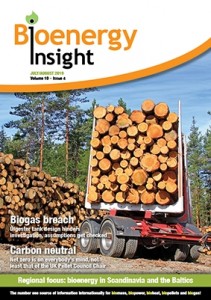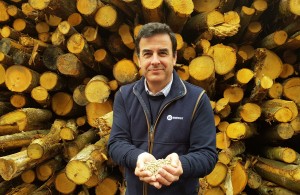Biomass from the field, to fuel for the future – Mark Lebus interview
 This article was first published in the July issue of Bioenergy Insight magazine (Volume 10, Issue 4 Published: July 16, 2019). To subscribe to the magazine or sign up for a free enewsletter visit: www.bioenergy-news.com
This article was first published in the July issue of Bioenergy Insight magazine (Volume 10, Issue 4 Published: July 16, 2019). To subscribe to the magazine or sign up for a free enewsletter visit: www.bioenergy-news.com
What was once wasted biomass is now being turned into renewable sources of energy like wood chips and wood pellets. UK Pellet Council Chair Mark Lebus talks us through the UK biomass industry and the Biomass Heat Works campaign
LC Energy founder and a director of Bioenergy Europe, UK Pellet Council Chair (UKPC) Mark Lebus met with Bioenergy Insight on the eve of his Bioenergy Europe board meeting in Brussels. He talks about accreditation, biomass engineering, the significance of sustainable supply chains and the importance of biomass as part of the renewable energy mix.
Mandated as the UK-license holder for the ENplus®, the transparent and independent certification scheme for wood pellets, the UKPC is a trade body working to serve end users, suppliers and traders to administer ENplus® certification. The responsibilities only begin there, as Lebus explains
“There are a number of other, more traditional things that a trade association provides the membership in functioning to represent members to government and policy holders; lobbying government, dealing with customer issues, ensuring that industry practices are understood, for communications support and campaigns, for advocacy, anything around pellets, but bearing in mind the primary function is as a license holder of the ENplus®. [The UKPC] is also very focused on standards, quality control, ensuring that accreditation is correctly in place — and everything that goes along with that.”
The UK uses about 6.7 million tonnes of wood pellets a year, and the bulk of that is for industrial scale applications, such as power stations like Drax. However, UKPC is predominantly concerned with premium wood pellet production, supply and utilisation in the UK, which is very different to the large power station market,
“The estimated demand in the UK for premium grade ENplus® A1 pellets is approximately 700,000 tonnes per annum. This is made up of UK manufactured pellets, estimated at 300,000 tonnes per annum, and imported European manufactured pellets, estimated at 400,000 tonnes per annum. These pellets are produced under strict ENplus® criteria for quality and sustainability, which is a very different product and market to the industrial pellets imported by the power stations,” says Lebus.
In terms of upping the percentage of UK-produced ENplus® A1 pellets, Lebus highlights the continuing need for backing,
“The UK production capacity is largely governed by investment and plant or equipment capacity, so the asks for UK government support for future growth of the sector after 2021 may allow for further investment in new UK capacity and production, however in my view, unless this support generates significant growth over the next 10 to 20 years, it is unlikely that the UK capacity will increase much.”
Reducing carbon emissions
At the time of going to print, the government announced that the UK was to have net-zero greenhouse gas emissions by 2050 and planned to legislate accordingly. It will come at considerable financial cost, and critics are quick to point that out; but the bigger-picture cost of not doing this is considerable too. Lebus talks about the renewable energy mix across
the bioenergy industry, and the part biomass already plays in that,
“Biomass has a couple of very key things that make it one of the most important technologies for decarbonisation of heat, and we are predominantly talking about heat rather than power — there are [combined heat and power] systems on a
slightly larger scale, but the majority of the market place is going to be for heat only.”
Decarbonisation won’t happen with biomass alone and Lebus clearly notes that it’s one of many important elements,
“Biomass is a renewable energy technology that is a part of the overall renewable technology mix, and realistically could deliver up to 15% or 20% of the overall UK decarbonisation targets. There’s also biomass availability consistently throughout the year; solar and wind have limitations in that respect. Biomass is classified as carbon neutral — absorbing as much carbon dioxide in the growth of the wood as it releases in the combustion of the wood when it emits the CO2,” says Lebus, “Biomass technology allows for a complete 365 days a year solution for heat energy, providing total seasonality that is not conditional. And because of its ability to focus very heavily on heat decarbonisation and can be used all year round, so it is a technology that needs to be considered not as a transition, but as a long-term solution that already exists.”
REA Bioenergy Strategy report
Last year, the Committee on Climate Change projected bioenergy could double as a proportion of the UK primary energy supply by 2050. However, the policies and regulatory framework have not been properly implemented. The Renewable
Energy Association (REA) Bioenergy Strategy report covers this in the first instalment released March this year and also addresses the technology’s current status and “the contribution of biomass as the UK leading source for renewable energy
specifically for decarbonising heat. Lebus describes,
“[The report] is specifically about biomass heat’s contribution to decarbonising the UK. It’s both in off-gas grid areas, but also urban areas and public buildings, hospitals, schools and so on — and the most important thing is that the strategy focuses heavily on sustainable feedstocks, about sourcing material — making sure to use really low value materials that come through the supply chain from UK forestry and agri-sectors in particular.”
The report’s second of three installments looks to the contribution biomass will make up to 2032. The government’s carbon budgets each span a five-year term, and the current third budget runs until 2022; carbon emissions must be reduced to 37% lower than 1990 levels.
The government states the first budget was met, the second and third are doing well, but that it’s not looking promising for the fourth, Lebus says.
“The key message is that the government is way behind the curve in terms of achieving its fourth and fifth carbon budgets, and we can demonstrate how biomass can help to achieve those budgets going forward, as long as the government see this as a long term solution to a renewable energy mix.”
The third instalment is due soon and will provide a set of policy proposals on how the vision will be delivered,
“The strategy itself is very comprehensive, and the REA are doing a tremendous job in driving the message and lobbying government and policy holders, the civil servants and the public at large, as to why the renewable energy mix must include things like biomass as part of the equation,” says Lebus, bringing it back to the core principle of emissions through heat particularly, “Government focus is very much on power and decarbonising electricity, and to some extent they have a very clear direction on how to deal with that, but because emissions are very significant as a proportion from heat alone, the government focus on bioenergy and biomass in particular is being thoroughly endorsed, supported and promoted by the REA and the new UKPC’s Biomass Heat Works! campaign. You can follow the campaign on social media with the hashtag, #BiomassHeatWorks.”
The Biomass Heat Works! campaign was launched in June by the UKPC as a collaborative message to government from the industry, including the REA and Wood Heat Association (WHA). The campaign is asking the government to consider future support to the biomass sector, which has already proven to deliver considerable carbon reduction, jobs and huge uplift in the rural economy. Ultimately, the campaign is about proposing to the government how biomass technology can contribute to the carbon budget deficit, by demonstrating that it’s already been doing it for years and presenting the evidence. One such item of proof is the Renewable Heat Incentive (RHI) itself,
“There are a number of asks that are really alternatives to the RHI, we recognise the subsidies for any particular sector are only there to raise momentum,” explains Lebus, “What’s happened is that the UK Government have demonstrated that through two rounds of the RHI, that they’ve been able to create a financial model with the checks and balances in place to very successfully create a market — allowed a market to be created through the pump priming.”
Talking of the fear in the bioenergy industry around the coming end of the RHI, Lebus wants to look forward to an adapting, or evolving of the RHI to incentivise producers,
“Where I think we are at odds with the government, is that the policy is looking to come to an abrupt end in March 2021, and because of that, when one sees a cliff edge, the appetite for investment diminishes very quickly.”
In accepting that the market is not yet able to capitalise on the cost of equipment, the UKPC has developed this advocacy campaign with the REA and WHA to present solutions,
“It doesn’t necessarily have to be a tariff subsidy, cash up front type scheme. There are a number of different recommendations we’re working on that may include things like tax breaks and incentives, which would allow more controls for the government and answer how to take the industry through to the next decade and beyond.”
Woodland management
In terms of the supply chain for biomass, whether it’s pellets or chips, sustainable supply chains are already in place, with established technical expertise and infrastructure,
“All of this is wrapped up into a solution that we can demonstrate to the government is a safe pair of hands. Although this is a very strong industry it still needs government support and policy going forwards to make sure that it’s part of the overall mix, because it can continue to deliver, against carbon budgets,” states Lebus, “Biomass utilises only sustainable supply chains, so woodland management with correct licences, particularly in terms of sourcing raw materials is an essential part of the biomass supply chain — woodland management is necessary to ensure that woodlands continue to grow, and helps to respond to one of the biggest myths that we have to bust as to why are trees being cut down?”
And the fact is that biomass is predominantly the very low value end of the tree, and it is part of a process of sustainable woodland management,
“So everything that we do has a supply chain accreditation to it, which insists that the wood is sourced legally and sustainably and allows us to demonstrate that every aspect of the supply chain is 100% virgin wood and can be legitimately traced right back to the woodland and there is no deforestation in this process: it is entirely under an accreditation scheme to ensure that the woodlands are managed sustainably — and that allows a significant long-term aspect being part of a robust supply chain for renewable tech,” Lebus clarifies.
“It’s about the guys in the woodland cutting the trees, it’s about the agricultural contractors that normally have much less work in the winter, but since the biomass sector has come into play, there’s work all year round now — farming in the summer and busy in the heating season,” he explains,
“You can see the investment in farming, in agricultural contractors. Less than half of UK woodlands are being managed, and that’s partly because there’s not enough value in them, but if you can demonstrate you need the wood to create pellets, or biomass — only the low-value tops of the trees, or the first thinnings — then suddenly there’s a long term market that’s already bringing more woodlands back into management.”
And then what happens?
“You create jobs, and with that you create an economy which all stems from the fact that if you put a boiler in, you need fuel for 20 years. It’s that pull that the forestry sector hasn’t had for a very long time,” Lebus says.
A previous director of the WHA, Lebus is in no doubt that the industry as a whole is united in terms of its ambition and its messaging, and the advocacy campaign is a collaborative effort that includes the REA and specifically the WHA. The WHA, REA and UKPC are saying to the government that they have demonstrated their policies are robust and strong and have the statistics and data behind that,
“It’s about showing that the industry is united in one voice and demonstrating to the government exactly how it can continue to operate a scheme, or number of schemes, promoting through policy and subsidy a renewable technology that can achieve and deliver on its targets.”
For more information: www.biomassheatworks.co.uk


